AFL 2023: Adelaide Crows score review blunder explained and how the AFL can fix the ARC
The AFL admits the goal umpiring system failed on Saturday night but that is cold comfort for Crows fans. Here is what happened, what should have happened and what can change.
AFL
Don't miss out on the headlines from AFL. Followed categories will be added to My News.
It was a phantom deflection and noise that led to a human error that ended Adelaide’s season on Saturday night.
The non-review of Ben Keays snap for goal with less than a minute to play as the Crows trailed by two points was a flashpoint for the game’s controversial goal review system.
But AFL boss Gillon McLachlan was adamant on Sunday it wasn’t the system or the AFL’s ARC that was to blame, but rather the umpire camped beneath the post.
Here is what happened – and what should have happened – when Keays’ kick cleared the goal line, and what can change.
WHAT DID HAPPEN
Keays was given a free kick for out of bounds on the full, played on and snapped towards goal, with the ball clearing the line with 1:15 on the clock.
While he and three other Crows celebrated a kick that would have put their team in front against the Swans, the goal umpire signalled a behind and patted the goalpost.
No field umpires conferred with the goal umpire and while every goal is automatically reviewed, behinds are not.
Sydney’s lead was cut to one point.
“He (the goal umpire) was definitive that it hit the post,” McLachlan said.
“It was a noise and a deflection. And on review, that is not the case.”

With four Crows missing from the team’s defensive zone, Sydney’s Jake Lloyd quickly took the kick-in and the Swans played out the final minute to hold on to the lead.
Replays shown on Fox Footy clearly show a gap between the ball and the post.
WHAT SHOULD HAVE HAPPENED
The goal umpire was certain the ball had hit the post but if there was any doubt, the kick should have been reviewed.
In that case, the goal umpire could have made a “soft call” that it was a goal and referred the score to the ARC, after conferring with a field umpire.
The ARC would have begun filtering through replays, including split-screen vision that was aired on Fox Footy that appeared to show the ball passing the post without any contact.
During this time the game would have been paused.
Once the ARC decided to overturn the umpire’s soft call, a goal would have been declared and the ball would have been bounced in the middle of the ground, with Adelaide now in the lead.
“I want to be unambiguous about that – if it has been reviewed, it would have been overturned and it would have been a goal,” McLachlan said.
The decision to refer a score is generally in the hands of the goal umpire, so it is not the field umpire’s prerogative to intervene and ask for a review, unless that umpire is sure it requires another look.
WHAT SHOULD CHANGE
Barely 12 hours passed before the AFL went through its next score review challenge, with umpire David Rodan referring a potential touched goal upstairs in the opening minutes of Sunday’s game between the Western Bulldogs and West Coast.
While Eagle Jamaine Jones was sure the ball hit his shin, a goal was paid to Bulldog Anthony Scott.
Umpires will naturally be more inclined to review any scores that are line-ball as the finals approach, and finals will see more camera angles available at most grounds.
The decision to review will largely remain in the hands of the goal umpire in the biggest moments, and last year Richmond’s Tom Lynch had a goal overturned in the dying moments of an elimination final against Brisbane, which the Tigers narrowly lost.
McLachlan showed no indication that umpires would be given any more power to pause the game if a kick-in has been taken, as he showed concern for the “flow” of the game.
In a change that would have to be made post-season, the AFL could look to the soccer for a solution.
As fans of the Matildas will attest, soccer’s VAR has added drama and some frustration to the sport.
Play continues during soccer while potential penalties are reviewed upstairs, with the game then stopped if a penalty is found.

The AFL could adopt a similar policy, with play to continue on in the case of a behind while the score is reviewed, and the umpire could then pause the game if the ARC rules it should have been a goal.
In footy there is a natural restart for any such interruption with a ball-up in the middle of the ground.
The AFL says all goals are reviewed and in the case a goal is altered to a behind, players can quickly reset for a kick-in.
Microchips in balls remains a work in progress, with the hope that tracking technology could immediately tell the ARC if the ball hit the post.
Cricket and basketball have integrated their own versions of “challenges” to umpire decisions in recent years, and some have floated whether an AFL captain could ask for a review.
In the NBA, coaches get one unsuccessful review per game and generally save them for later in games, but those reviews are for any decision, not scoring.
McLachlan’s worries about the flow of the game make captain’s challenges unlikely.
More Coverage
Originally published as AFL 2023: Adelaide Crows score review blunder explained and how the AFL can fix the ARC





